
Researchers Trace Dust Grain's Journey Through Newborn Solar System
Combining atomic-scale sample analysis and models simulating likely conditions in the nascent solar system, a new study reveals clues about the origin of crystals that formed more than 4.5 billion years ago.Researchers Trace Dust Grain's Journey Through Newborn Solar System
×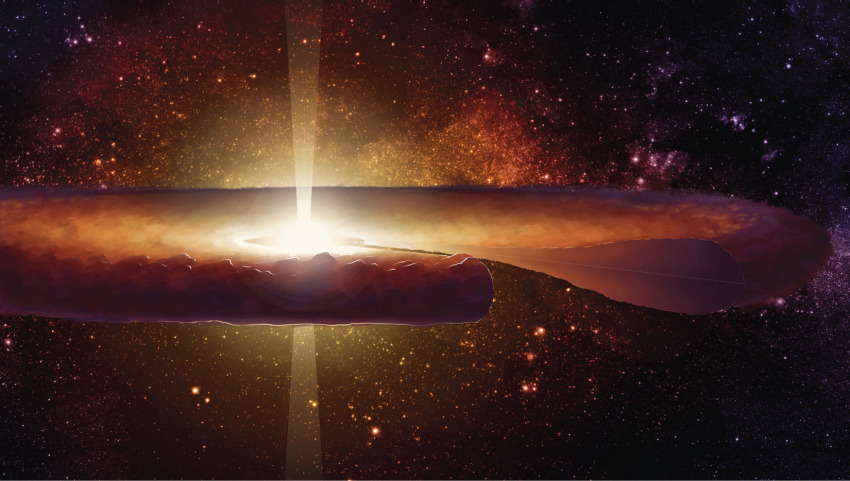
Artist’s illustration of the early solar system, at a time when no planets had formed yet. A swirling cloud of gas and dust surrounded the young sun. The cutaway through this so-called protoplanetary disk shows its three-dimensional structure. Heather Roper
A research team led by the University of Arizona has reconstructed in unprecedented detail the history of a dust grain that formed during the birth of the solar system more than 4.5 billion years ago. The findings provide insights into the fundamental processes underlying the formation of planetary systems, many of which are still shrouded in mystery.
For the study, the team developed a new type of framework, which combines quantum mechanics and thermodynamics, to simulate the conditions to which the grain was exposed during its formation, when the solar system was a swirling disk of gas and dust known as a protoplanetary disk or solar nebula. Comparing the predictions from the model to an extremely detailed analysis of the sample's chemical makeup and crystal structure, along with a model of how matter was transported in the solar nebula, revealed clues about the grain's journey and the environmental conditions that shaped it along the way.
The grain analyzed in the study is one of several inclusions, known as calcium-aluminum rich inclusions, or CAIs, discovered in a sample from the Allende meteorite, which fell over the Mexican state of Chihuahua in 1969. CAIs are of special interest because they are thought to be among the first solids that formed in the solar system more than 4.5 billion years ago.
Similar to how stamps in a passport tell a story about a traveler's journey and stops along the way, the samples' micro- and atomic-scale structures unlock a record of their formation histories, which were controlled by the collective environments to which they were exposed.
"As far as we know, our paper is the first to tell an origin story that offers clues about the likely processes that happened at the scale of astronomical distances with what we see in our sample at the scale of atomic distances," said Tom Zega, a professor in the University of Arizona's Lunar and Planetary Laboratory and the first author of the paper, published in The Planetary Science Journal.
Zega and his team analyzed the composition of the inclusions embedded in the meteorite using cutting-edge atomic-resolution scanning transmission electron microscopes – one at UArizona's Kuiper Materials Imaging and Characterization Facility, and its sister microscope located at the Hitachi factory in Hitachinaka, Japan.
The inclusions were found to consist mainly of types of minerals known as spinel and perovskite, which also occur in rocks on Earth and are being studied as candidate materials for applications such as microelectronics and photovoltaics.
Similar kinds of solids occur in other types of meteorites known as carbonaceous chondrites, which are particularly interesting to planetary scientists as they are known to be leftovers from the formation of the solar system and contain organic molecules, including those that may have provided the raw materials for life.
Precisely analyzing the spatial arrangement of atoms allowed the team to study the makeup of the underlying crystal structures in great detail. To the team's surprise, some of the results were at odds with current theories on the physical processes thought to be active inside protoplanetary disks, prompting them to dig deeper.
"Our challenge is that we don't know what chemical pathways led to the origins of these inclusions," Zega said. "Nature is our lab beaker, and that experiment took place billions of years before we existed, in a completely alien environment."
Zega said the team set out to "reverse-engineer" the makeup of the extraterrestrial samples by designing new models that simulated complex chemical processes, which the samples would be subjected to inside a protoplanetary disk.
"Such models require an intimate convergence of expertise spanning the fields of planetary science, materials science, mineral science and microscopy, which was what we set out to do," added Krishna Muralidharan, a study co-author and an associate professor in the UArizona's Department of Materials Science and Engineering.
Based on the data the authors were able to tease from their samples, they concluded that the particle formed in a region of the protoplanetary disk not far from where Earth is now, then made a journey closer to the sun, where it was progressively hotter, only to later reverse course and wash up in cooler parts farther from the young sun. Eventually, it was incorporated into an asteroid, which later broke apart into pieces. Some of those pieces were captured by Earth's gravity and fell as meteorites.
The samples for this study were taken from the inside of a meteorite and are considered primitive – in other words, unaffected by environmental influences. Such primitive material is believed to not have undergone any significant changes since it first formed more than 4.5 billion years ago, which is rare. Whether similar objects occur in asteroid Bennu, samples of which will be returned to Earth by the UArizona-led OSIRIS-REx mission in 2023, remains to be seen. Until then, scientists rely on samples that fall to Earth via meteorites.
"This material is our only record of what happened 4.567 billion years ago in the solar nebula," said Venkat Manga, a co-author of the paper and an assistant research professor in the UArizona Department of Materials Science and Engineering. "Being able to look at the microstructure of our sample at different scales, down to the length of individual atoms, is like opening a book."
The authors said that studies like this one could bring planetary scientists a step closer to "a grand model of planet formation" – a detailed understanding of the material moving around the disk, what it is composed of, and how it gives rise to the sun and the planets.
Powerful radio telescopes like the Atacama Large Millimeter/submillimeter Array, or ALMA, in Chile now allow astronomers to see stellar systems as they evolve, Zega said.
"Perhaps at some point we can peer into evolving disks, and then we can really compare our data between disciplines and begin answering some of those really big questions," Zega said. "Are these dust particles forming where we think they did in our own solar system? Are they common to all stellar systems? Should we expect the pattern we see in our solar system – rocky planets close to the central star and gas giants farther out – in all systems?
"It's a really interesting time to be a scientist when these fields are evolving so rapidly," he added. "And it's awesome to be at an institution where researchers can form transdisciplinary collaborations among leading astronomy, planetary and materials science departments at the same university."
The study was co-authored by Fred Ciesla at the University of Chicago and Keitaro Watanabe and Hiromi Inada, both with the Nano-Technology Solution Business Group at Hitachi High-Technologies Corp. in Japan.
Funding was provided through NASA's Emerging Worlds Program; NASA's Origins Program; and NASA's Nexus for Exoplanet System Science (NExSS) research coordination network, which is sponsored by NASA's Science Mission Directorate. NASA and the National Science Foundation provided the funding for the instrumentation in LPL's Kuiper Materials Imaging and Characterization Facility.
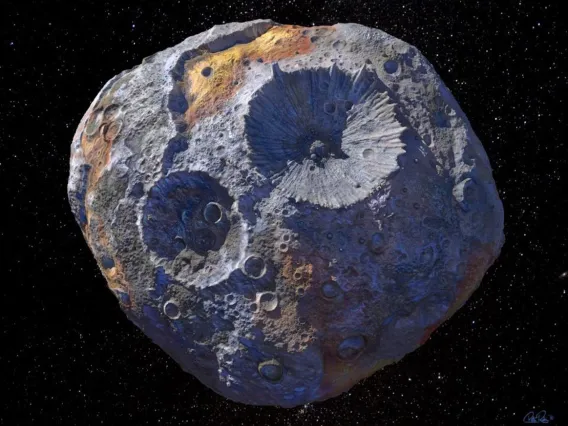
Asteroid 16 Psyche Might Not Be What Scientists Expected
New UArizona research finds that the target asteroid of NASA's Psyche mission may not be as metallic or dense as previously predicted.
Asteroid 16 Psyche Might Not Be What Scientists Expected
×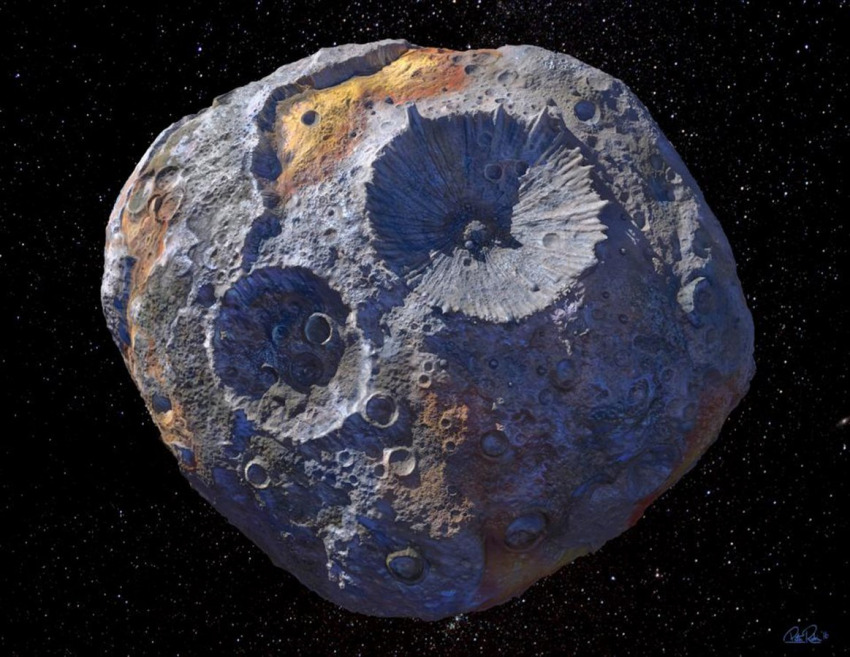
By Mikayla Mace Kelley, University Communications - June 9, 2021
The widely studied metallic asteroid known as 16 Psyche was long thought to be the exposed iron core of a small planet that failed to form during the earliest days of the solar system. But new University of Arizona-led research suggests that the asteroid might not be as metallic or dense as once thought, and hints at a much different origin story.
Scientists are interested in 16 Psyche because if its presumed origins are true, it would provide an opportunity to study an exposed planetary core up close. NASA is scheduled to launch its Psyche mission in 2022 and arrive at the asteroid in 2026.
UArizona undergraduate student David Cantillo is lead author of a new paper published in The Planetary Science Journal that proposes 16 Psyche is 82.5% metal, 7% low-iron pyroxene and 10.5% carbonaceous chondrite that was likely delivered by impacts from other asteroids. Cantillo and his collaborators estimate that 16 Psyche's bulk density – also known as porosity, which refers to how much empty space is found within its body – is around 35%.
These estimates differ from past analyses of 16 Psyche's composition that led researchers to estimate it could contain as much as 95% metal and be much denser.
"That drop in metallic content and bulk density is interesting because it shows that 16 Psyche is more modified than previously thought," Cantillo said.
Rather than being an intact exposed core of an early planet, it might actually be closer to a rubble pile, similar to another thoroughly studied asteroid — Bennu. UArizona leads the science mission team for NASA's OSIRIS-REx mission, which retrieved a sample from Bennu's surface that is now making its way back to Earth.
"Psyche as a rubble pile would be very unexpected, but our data continues to show low-density estimates despite its high metallic content," Cantillo said.
Asteroid 16 Psyche is about the size of Massachusetts, and scientists estimate it contains about 1% of all asteroid belt material. First spotted by an Italian astronomer in 1852, it was the 16th asteroid ever discovered.
"Having a lower metallic content than once thought means that the asteroid could have been exposed to collisions with asteroids containing the more common carbonaceous chondrites, which deposited a surface layer that we are observing," Cantillo said. This was also observed on asteroid Vesta by the NASA Dawn spacecraft.
Asteroid 16 Psyche has been estimated to been worth $10,000 quadrillion (that's $10,000 followed by 15 more zeroes), but the new findings could slightly devalue the iron-rich asteroid.
"This is the first paper to set some specific constraints on its surface content. Earlier estimates were a good start, but this refines those numbers a bit more," Cantillo said.
The other well-studied asteroid, Bennu, contains a lot of carbonaceous chondrite material and has porosity of over 50%, which is a classic characteristic of a rubble pile.
Such high porosity is common for relatively small and low-mass objects such as Bennu – which is only as large as the Empire State Building – because a weak gravitational field prevents the object's rocks and boulders from being packed together too tightly. But for an object the size of 16 Psyche to be so porous is unexpected.
"The opportunity to study an exposed core of a planetesimal is extremely rare, which is why they're sending the spacecraft mission there," Cantillo said, "but our work shows that 16 Psyche is a lot more interesting than expected."
Past estimates of 16 Psyche's composition were done by analyzing the sunlight reflected off its surface. The pattern of light matched that of other metallic objects. Cantillo and his collaborators instead recreated 16 Psyche's regolith – or loose rocky surface material – by mixing different materials in a lab and analyzing light patterns until they matched telescope observations of the asteroid. There are only a few labs in the world practicing this technique, including the UArizona Lunar and Planetary Laboratory and the Johns Hopkins Applied Physics Laboratory in Maryland, where Cantillo worked while in high school.
"I've always been interested in space," said Cantillo, who is also president of the UArizona Astronomy Club. "I knew that astronomy studies would be heavy on computers and observation, but I like to do more hands-on kind of work, so I wanted to connect my studies to geology somehow. I'm majoring geology and minoring in planetary science and math."
"David's paper is an example of the cutting-edge research work done by our undergraduate students," said study co-author Vishnu Reddy, an associate professor of planetary sciences who heads up the lab in which Cantillo works. "It is also a fine example of the collaborative effort between undergraduates, graduate students, postdoctoral fellows and staff in my lab."
The researchers also believe the carbonaceous material on 16 Psyche's surface is rich in water, so they will next work to merge data from ground-based telescopes and spacecraft missions to other asteroids to help determine the amount of water present.
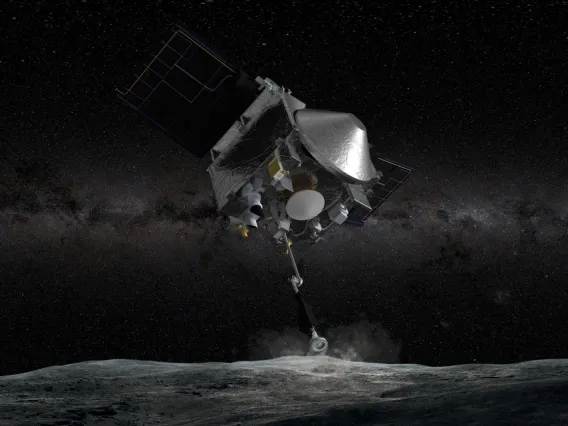
$2M Gift Advances UArizona Space Science Initiatives
The gift will enable the purchase of a nanoscale secondary ion mass spectrometer, an instrument the analysis team will use to help find answers to fundamental questions about the origins of the solar system.
$2M Gift Advances UArizona Space Science Initiatives
×
University of Arizona Foundation - May 25, 2021
In October, NASA's OSIRIS-REx spacecraft made the agency's first attempt to collect a sample from the asteroid Bennu during a mission led by the University of Arizona.
Among those following along was assistant professor and cosmochemist Jessica Barnes, assistant professor of planetary sciences and a collaborating sample scientist on the mission. She and her colleagues at the UArizona Lunar and Planetary Laboratory were elated when the touch-and-go event succeeded. Then they worried after the mission team learned some particles were escaping the sample collector and spent two days working around the clock to secure the material.
"That was a really surreal time," Barnes said.
Around the time Barnes learned the collector head had been closed with an abundant sample, she received more good news: Someone had made a $1.5 million gift toward sample analysis. The gift will enable the purchase of a nanoscale secondary ion mass spectrometer, an instrument the analysis team will use to help find answers to fundamental questions about the origins of the solar system. The project is funded in part by a grant from the Gordon and Betty Moore Foundation, as well as the university.
Barnes called Dante Lauretta, professor of planetary sciences and principal investigator of OSIRIS-REx, to share the news.
"I was emotional, as was Dante. To hear we have this wonderful gift that enables us to get this amazing piece of equipment – I had no idea that would happen at that time. It was just amazing," Barnes said.
The timing was noteworthy, Lauretta said, not only because he'd just learned the sample collection was successful, but because 2020 had presented so many difficulties.
"I was overwhelmed with emotion and joy and excitement – for Jessica, for the university, for our samples, for science, for our students and staff and everybody that's going to be involved in the continuation of this amazing scientific adventure," he said.
The donor, who asked to remain anonymous, is a UArizona graduate who made a previous major gift so that the university’s students and faculty will have more time using the Giant Magellan Telescope when it's completed and begins operations at its home in Chile's Atacama Desert. This gift allocated another $500,000 in support of UArizona’s role in the GMT project as well as the $1.5 million to provide the balance required for the sample analysis instrument.
"I am immensely grateful for this donor's vision and support of space science exploration at the University of Arizona," said university President Robert C. Robbins. "One of the most thrilling aspects of both of these projects is realizing how many members of our faculty and staff, as well as our students, are contributing to their success. It is incredible to have a graduate continue engaging with the university and supporting these missions.”
The donor's decision to contribute to the OSIRIS-REx mission arose partly from admiration for Barnes' expertise in sample analysis and from an interest in supporting an early-career female scientist, said Elliott Cheu, interim dean of the College of Science.
Barnes joined the Lunar and Planetary Laboratory in 2019 following a postdoctoral fellowship at NASA's Johnson Space Center in Houston. She received her doctorate from The Open University in the U.K.
The College of Science is fortunate to be able to attract world-leading faculty, said Cheu, who will continue as interim dean until June, when Carmala Garzione will become permanent dean.
"When donors step up to become partners in discovery, they empower those researchers to realize their potential and accelerate our progress. This remarkable gift ensures we can make the most of our team's knowledge and the sample so many have worked long and hard to retrieve," Cheu said.
Private gifts are often a crucial component of university research projects, said John-Paul Roczniak, president and CEO of the UArizona Foundation.
"This gift helps accelerate scientific breakthroughs. I'm grateful to this donor and all our supporters who make generous investments in research with far-reaching consequences for society," Roczniak said.
The OSIRIS-REx spacecraft is scheduled to return to Earth in September 2023, with the sample capsule touching down at the Utah Test and Training Range. Following initial identification and processing at the Johnson Space Center, a team led by Lauretta will begin detailed analysis at UArizona. The goal is to explore the solar system's past and secure its future, according to Lauretta.
The nanoscale secondary ion mass spectrometer allows investigation to the nanometer scale, Barnes said. She expects the instrument to provide a wealth of information over many years without destroying the samples, thereby extending the discovery timeline.
"Depending on how much material we brought back from Bennu, scientists and students could be analyzing those materials a decade or even two or three decades into the future," Barnes said.
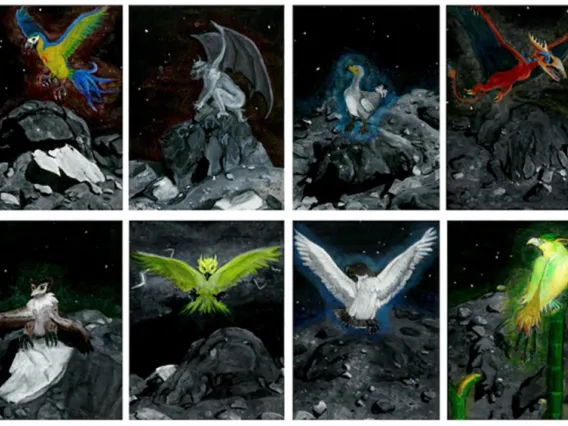
Bennu in the Sky, on the Canvas and (Soon) in Zoe Zeszut's Hands
Zoe Zeszut painted mythological birds perched on the Bennu features that carry their names.
Bennu in the Sky, on the Canvas and (Soon) in Zoe Zeszut's Hands
×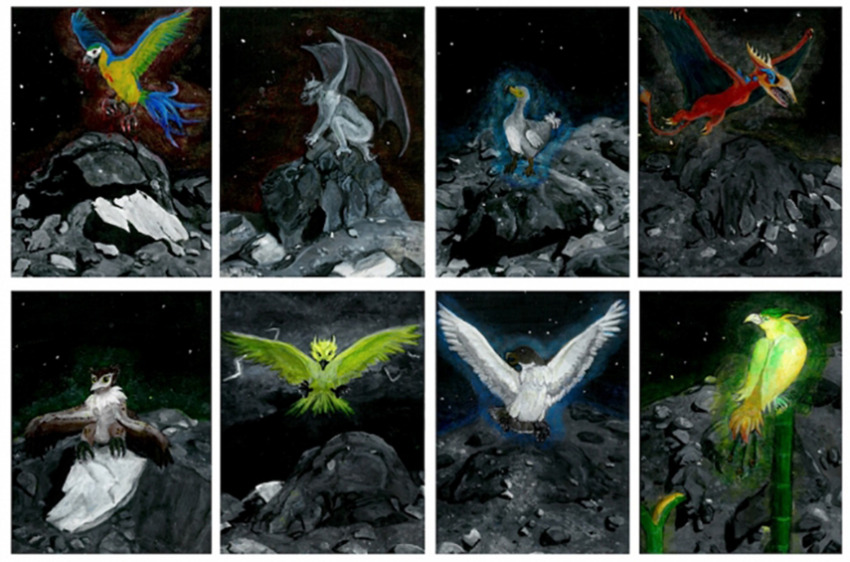
By Mikayla Mace Kelley, University Communications - May 17, 2021
The near-Earth asteroid Bennu is nearly always on Zoe Zeszut's mind.
As a former operations engineer for NASA's University of Arizona-led OSIRIS-REx mission, she coded and verified commands to maneuver the spacecraft and capture images of the asteroid's surface.
In her new role in the Kuiper Materials Imaging and Characterization Facility, she will analyze the asteroid rocks and dust upon the sample's return.
Her work with space rocks also bleeds into her hobbies. As an artist, she interprets the data and mission symbolism in creative ways through her paintings.
During a typical planning cycle on the OSIRIS-REx mission, Zeszut and her teammates started by building plans weeks ahead of time. The plans were designed to capture images of the surface with good exposure and lighting with the least risk to the spacecraft. Next, the team turned the plans into coding language that the onboard systems could understand. Then, the commands went through layers of reviews by mission members before they were sent to Lockheed Martin, which built the spacecraft and provides flight operations. At Lockheed, the code was run through a spacecraft simulator and the results were reviewed by the University of Arizona team to ensure there were no conflicting or harmful commands. If everything ran smoothly, Lockheed sent the commands to the spacecraft. After the spacecraft completed an observation, Zeszut and the operations team monitored the operations to confirm that all acquired data was sent to Earth.
Zeszut, pronounced zes-zoot, joined OSIRIS-REx in March 2018, right before an operational readiness test in which the team ran through what would happen during actual mission operations. Since then, she's been there for arrival, orbital insertion, mapping, site selection, the touch-and-go sample collection in October 2020 and the final flyby last month.
Her contract with the OSIRIS-REx mission expired in mid-April, around the same time the spacecraft was preparing to return home with its sample on board.
But before she joined the team that will analyze the samples in 2023, Zeszut made many Bennu-inspired paintings.
"The name Bennu comes from a heron in an Egyptian creation story, so it was determined that features – such as boulders and craters – on Bennu would be named after other legendary birds," Zeszut said. "Some of them are quite vicious, like a Mayan parrot that decapitates people, a winged pterodactyl-like creature that breaks boats apart and a witch owl that kidnaps children. But others seem much friendlier – like benevolent birds of creation or even the Dodo bird from 'Alice in Wonderland.'"
Zeszut has created about 20 Bennu paintings. Each one portrays a feature of the asteroid's surface with the associated mythical bird flying just above. She also has painted more realistic depictions of Bennu's surface.
For inspiration, she turns to artists such as William Hartmann, whose paintings are found hanging in the Lunar and Planetary Laboratory and on the covers of some of Zeszut's textbooks.
Zeszut herself displayed some of her paintings to the annual "Art of Planetary Science" exhibit.
Zeszut loves nature, which is reflected by her choice of subjects. She often paints landscapes, animals, fossils, rocks and crystals.
"I like that my work and my hobbies are both creative in some way," she said. "You have to be innovative and insightful to do science. Like putting a puzzle together, you're trying to fit observation guidelines, science goals and spacecraft requirements together into one plan that runs successfully. I approach my art in a similar way. I like that I can bring work into hobbies and enjoy thinking about it even when I'm off the clock."
Zeszut found herself on the OSIRIS-REx team after graduating with a master's degree in planetary geology from Case Western Reserve University. There, she specifically studied asteroid and meteorite minerology and physical properties.
"During my graduate research, I kept coming across OSIRIS-REx stuff," she said. "I've always been interested in the mission, so when I finally finished my program and started searching for jobs, I found my position at OSIRIS-REx."
She started her undergraduate career in astrophysics at Ohio University, but quickly discovered it wasn't a perfect fit.
"I've always been interested in natural sciences, and I knew I wanted to have one of those majors. But shortly after starting in astrophysics, I switched because the program was mostly theoretical classes. I wanted my eye to the telescope, or at least something more hands on. Some friends in the geology department were taking classes like the geology of Mars and planetary geology, so I thought, 'Maybe that's the way to get into this.' I ended up switching to that major and got a bachelor's in geological sciences."
At the same time, she also completed a bachelor's degree in digital media and communications. She's always been drawn to graphics, art and video, she said.
Now, at the Kuiper Imaging Facility, her main duty will be managing and maintaining the labs that house the scanning electron microscope and the focused-ion-beam scanning electron microscope. Housed in the basement of the Kuiper Space Sciences Building, the faculty was founded in 2016 to support research on extraterrestrial materials.
"Going back to working with this kind of equipment is more like what I was doing in grad school, though some of the machines I used back then were decades older, so it's a bit like stepping into the 21st century as I'm learning about the equipment at Kuiper," she said.
She will also be part of the OSIRIS-REx sample analysis team when the sample return capsule is released from the spacecraft and lands in the Utah desert on Sept. 21, 2023. In the meantime, she and her new team will spend the next few years preparing for microscopic analysis.
Similar to her first days with the OSIRIS-REx mission, "we will be doing a sample analysis readiness test – a sort of practice run – in a few months. The Kuiper Imaging Facility will be at the center of the University's sample analysis work."
And just like before, it's likely her work will continue to find its way into her paintings.
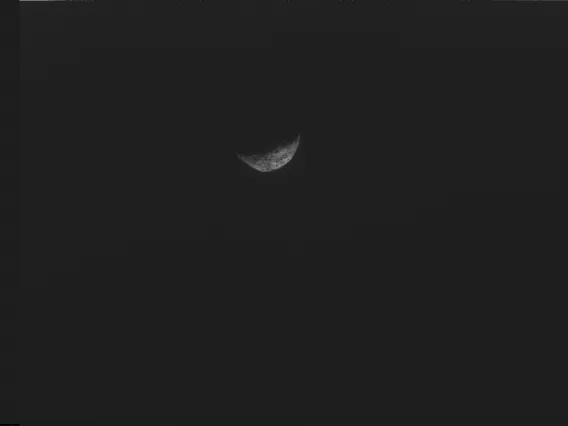
OSIRIS-REx Spacecraft is Headed Home with Asteroid Sample
After nearly five years in space, the OSIRIS-REx spacecraft is on its way back to Earth with an abundance of rocks and dust from near-Earth asteroid Bennu.
OSIRIS-REx Spacecraft is Headed Home with Asteroid Sample
×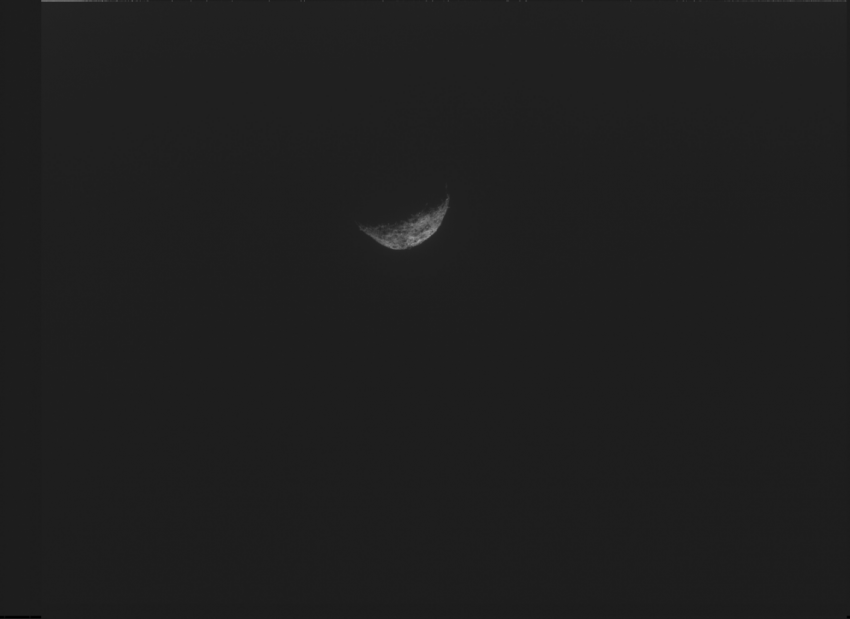
University Communications and NASA Goddard Space Flight Center - May 10, 2021
On Monday, May 10 at 1:23 p.m. Arizona time, the University of Arizona-led OSIRIS-REx spacecraft fired its main engines full throttle for seven minutes – its most significant maneuver since it arrived at asteroid Bennu in 2018. The burn thrust the spacecraft away from the asteroid at 600 mph, setting it on a two-and-a-half-year cruise toward Earth.
"As we leave the asteroid, I'm feeling very proud," said mission principal investigator Dante Lauretta, a UArizona professor of planetary sciences. "This team has performed phenomenally. We've learned a lot throughout this whole mission and now we're looking forward to the final science campaign of sample analysis, which is why I got involved in this program so long ago in the first place. The samples will yield decades of science once they are safely returned to Earth."
After orbiting the sun twice, the OSIRIS-REx spacecraft is due to reach Earth on Sept. 24, 2023. Upon return, the capsule containing pieces of Bennu will separate from the rest of the spacecraft and enter Earth's atmosphere. The capsule will parachute to the Utah Test and Training Range in Utah's West Desert, where scientists will be waiting to retrieve it.
"OSIRIS-REx's many accomplishments demonstrated the daring and innovate way in which exploration unfolds in real time," said Thomas Zurbuchen, associate administrator for science at NASA Headquarters. "The team rose to the challenge, and now we have a primordial piece of our solar system headed back to Earth where many generations of researchers can unlock its secrets."
To realize the mission's multi-year plan, a dozen navigation engineers made calculations and wrote computer code to instruct the spacecraft when and how to push itself away from Bennu. After departing from Bennu, getting the sample to Earth safely is the team's next critical goal. This includes planning future maneuvers to keep the spacecraft on course throughout its journey.
"Our whole mindset has been, 'Where are we in space relative to Bennu?'" said Mike Moreau, OSIRIS-REx deputy project manager at NASA's Goddard Space Flight Center in Greenbelt, Maryland. "Now our mindset has shifted to 'Where is the spacecraft in relation to Earth?'"
The navigation cameras that helped orient the spacecraft in relation to Bennu were turned off April 9, after snapping their last images of the asteroid. With Bennu in the rearview mirror, engineers are using NASA's Deep Space Network of global spacecraft communications facilities to steer the spacecraft by sending it radio signals. By measuring the frequency of the waves returned from the spacecraft transponder, engineers can tell how fast OSIRIS-REx is moving. Engineers measure how long it takes for radio signals to get from the spacecraft back to Earth in order to determine its location.
Exceeding Mission Expectations
The May 10 departure date was precisely timed based on the alignment of Bennu with Earth. The goal of the return maneuver is to get the spacecraft within about 6,000 miles of Earth in September 2023. Although OSIRIS-REx still has plenty of fuel remaining, the team is trying to preserve as much as possible for a potential extended mission to another asteroid after returning the sample capsule to Earth. The team will investigate the feasibility of such a mission this summer.
The spacecraft's course will be determined mainly by the sun's gravity, but engineers will need to occasionally make small course adjustments via engine burns.
"We need to do regular corrections to bring the trajectory increasingly closer to Earth's atmosphere for the sample release, and to account for small errors that might have accumulated since the last burn," said Peter Antreasian, OSIRIS-REx navigation lead at KinetX Aerospace, which is based in Simi Valley, California.
The team will perform course adjustments a few weeks prior to Earth re-entry in order to precisely target the location and angle for the sample capsule’s release into Earth's atmosphere. Coming in too low could cause the capsule to bounce out of the atmosphere like a pebble skipping off a lake; too high and the capsule could burn up due to friction and heat from the atmosphere. If OSIRIS-REx fails to release the capsule, the team has a backup plan to divert it away from Earth and try again in 2025.
"There's a lot of emotion within the team about departure," Moreau said. "I think everyone has a great sense of accomplishment, because we faced all these daunting tasks and were able to accomplish all the objectives thrown at us. But there's also some nostalgia and disappointment that this part of the mission is coming to an end."
OSIRIS-REx exceeded many expectations. Most recently, in the midst of a global pandemic, the team flawlessly executed the most mission’s critical operation, collecting more than 2 ounces, or 60 grams, of soil from Bennu's surface.
Leading up to sample collection, a number of surprises kept the team on its toes. For example, a week after the spacecraft entered its first orbit around Bennu on Dec. 31, 2018, the team realized that the asteroid was releasing small pieces of rock into space.
"We had to scramble to verify that the small particles being ejected from the surface did not present a hazard to the spacecraft," Moreau said.
Upon arrival at the asteroid, team members also were astonished to find that Bennu is littered with boulders.
"We really had this idea that we were arriving on an asteroid with open real estate," said Heather Enos, OSIRIS-REx deputy principal investigator, based at UArizona. "The reality was a big shocker."
To overcome the extreme and unexpected ruggedness of Bennu's surface, engineers had to quickly develop a more accurate navigation technique to target smaller-than-expected sites for sample collection.
The OSIRIS-REx mission was instrumental in both confirming and refuting several scientific expectations. Among those confirmed was the success of a technique that used observations from Earth to predict that the minerals on the asteroid would be carbon-rich and show signs of ancient water. One expectation that was disproved was that Bennu would have a smooth surface, which scientists predicted by measuring how much heat radiated off its surface.
Scientists will use the information gleaned from Bennu to refine theoretical models and improve future predictions.
"This mission emphasizes why we have to do science and exploration in multiple ways – both from Earth and from up-close in space – because assumptions and models are just that," Enos said.
The University of Arizona leads the OSIRIS-REx science team and the mission's science observation planning and data processing. NASA's Goddard Space Flight Center in Greenbelt, Maryland, provides overall mission management, systems engineering, and the safety and mission assurance for OSIRIS-REx. Lockheed Martin Space in Littleton, Colorado, built the spacecraft and provides flight operations. Goddard and KinetX Aerospace are responsible for navigating the OSIRIS-REx spacecraft. OSIRIS-REx is the third mission in NASA's New Frontiers Program, managed by NASA's Marshall Space Flight Center in Huntsville, Alabama, for the agency's Science Mission Directorate Washington, D.C.
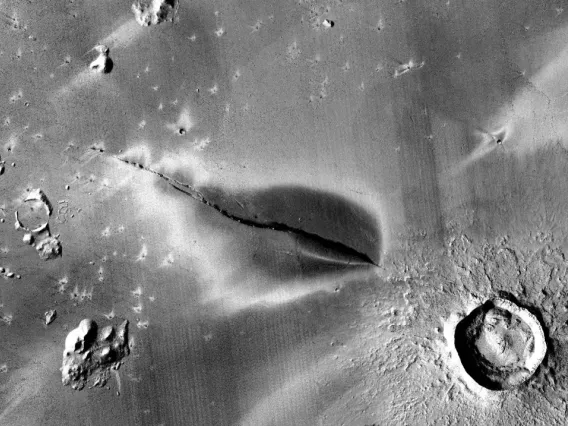
Volcanoes on Mars Could be Active, Raising Possibility that the Planet was Recently Habitable
New observations reveal that Mars could still be volcanically active, raising the possibility for habitable conditions below the surface of Mars in recent history.
Volcanoes on Mars Could be Active, Raising Possibility that the Planet was Recently Habitable
×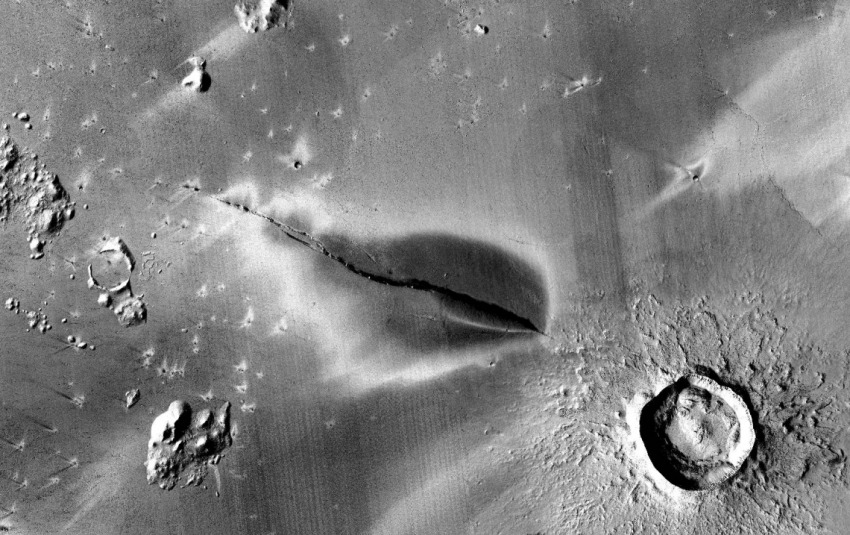
By Daniel Stolte, University Communications, and Alan Fischer, Planetary Science Institute - May 6, 2021
Evidence of recent volcanic activity on Mars shows that eruptions could have taken place in the past 50,000 years, according to new study by researchers at the University of Arizona's Lunar and Planetary Laboratory and the Planetary Science Institute.
Most volcanism on the Red Planet occurred between 3 and 4 billion years ago, with smaller eruptions in isolated locations continuing perhaps as recently as 3 million years ago. But, until now, there was no evidence to indicate Mars could still be volcanically active.
Using data from satellites orbiting Mars, researchers discovered a previously unknown volcanic deposit. They detail their findings in the paper "Evidence for geologically recent explosive volcanism in Elysium Planitia, Mars," published in the journal Icarus.
"This may be the youngest volcanic deposit yet documented on Mars," said lead study author David Horvath, who did the research as a postdoctoral researcher at UArizona and is now a research scientist at the Planetary Science Institute. “If we were to compress Mars' geologic history into a single day, this would have occurred in the very last second.”
The volcanic eruption produced an 8-mile-wide, smooth, dark deposit surrounding a 20-mile-long volcanic fissure.
"When we first noticed this deposit, we knew it was something special," said study co-author Jeff Andrews-Hanna, an associate professor at the UArizona Lunar and Planetary Laboratory and the senior author on the study. "The deposit was unlike anything else found in the region, or indeed on all of Mars, and more closely resembled features created by older volcanic eruptions on the Moon and Mercury."
Further investigation showed that the properties, composition and distribution of material match what would be expected for a pyroclastic eruption – an explosive eruption of magma driven by expanding gasses, not unlike the opening of a shaken can of soda.
The majority of volcanism in the Elysium Planitia region and elsewhere on Mars consists of lava flowing across the surface, similar to recent eruptions in Iceland being studied by co-author Christopher Hamilton, a UArizona associate professor of lunar and planetary sciences. Although there are numerous examples of explosive volcanism on Mars, they occurred long ago. However, this deposit appears to be different.
"This feature overlies the surrounding lava flows and appears to be a relatively fresh and thin deposit of ash and rock, representing a different style of eruption than previously identified pyroclastic features," Horvath said. "This eruption could have spewed ash as high as 6 miles into Mars' atmosphere. It is possible that these sorts of deposits were more common but have been eroded or buried."
The site of the recent eruption is about 1,000 miles (1,600 kilometers) from NASA's InSight lander, which has been studying seismic activity on Mars since 2018. Two Marsquakes, the Martian equivalent of earthquakes, were found to originate in the region around the Cerberus Fossae, and recent work has suggested the possibility that these could be due to the movement of magma deep underground.
"The young age of this deposit absolutely raises the possibility that there could still be volcanic activity on Mars, and it is intriguing that recent Marsquakes detected by the InSight mission are sourced from the Cerberus Fossae," Horvath said. In fact, the team of researchers predicted this to be a likely location for Marsquakes several months before NASA's InSight lander touched down on Mars.
A volcanic deposit such as this one also raises the possibility for habitable conditions below the surface of Mars in recent history, Horvath said.
"The interaction of ascending magma and the icy substrate of this region could have provided favorable conditions for microbial life fairly recently and raises the possibility of extant life in this region," he said.
Similar volcanic fissures in this region were the source of enormous floods, perhaps as recently as 20 million years ago, as groundwater erupted out onto the surface.
Elysium Planitia, the region of recent explosive volcanism (white box) and NASA's InSight lander. Overlooking the plain is Elysium Mons, a volcano towering nearly 8 miles above its base.MOLA Science Team
Andrews-Hanna's research group continues to investigate the causes of the eruption. Pranabendu Moitra, a research scientist in the UArizona Department of Geosciences, has been probing the mechanism behind the eruption.
An expert in similar explosive eruptions on Earth, Moitra developed models to look at the possible cause of the Martian eruption. In a forthcoming paper in the journal Earth and Planetary Science Letters, he suggests that the explosion either could have been a result of gases already present in the Martian magma, or it could have happened when the magma came into contact with Martian permafrost.
"The ice melts to water, mixes with the magma and vaporizes, forcing a violent explosion of the mixture," Moitra said. "When water mixes with magma, it's like pouring gasoline on a fire."
He also points out that the youngest volcanic eruption on Mars happened only 6 miles (10 kilometers) from the youngest large-impact crater on the planet – a 6-mile-wide crater named Zunil.
"The ages of the eruption and the impact are indistinguishable, which raises the possibility, however speculative, that the impact actually triggered the volcanic eruption," Moitra said.
Several studies have found evidence that large quakes on Earth can cause magma stored beneath the surface to erupt. The impact that formed the Zunil crater on Mars would have shaken the Red Planet just like an earthquake, Moitra explained.
While the more dramatic giant volcanoes elsewhere on Mars – such as Olympus Mons, the tallest mountain in the solar system – tell a story of the planet's ancient dynamics, the current hotspot of Martian activity seems to be in the relatively featureless plains of the planet's Elysium region.
Andrews-Hanna said it's remarkable that one region hosts the epicenters of present-day earthquakes, the most recent floods of water, the most recent lava flows, and now an even more recent explosive volcanic eruption.
"This may be the most recent volcanic eruption on Mars," he said, "but I think we can rest assured that it won't be the last."
The volcanic deposit described in this study, along with ongoing seismic rumbling in the planet's interior detected by InSight and possible evidence for releases of methane plumes into the atmosphere detected by NASA's MAVEN orbiter, suggest that Mars is far from a cold, inactive world, Andrews-Hanna said.
"All these data seem to be telling the same story," he said. "Mars isn't dead."
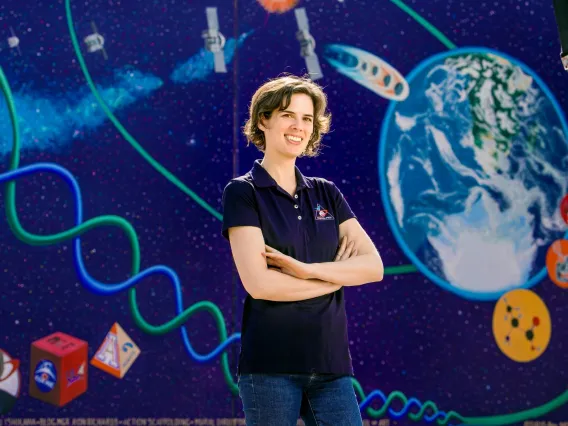
Behind the Scenes with Carina Bennett
In 2019, the University of Arizona rolled out a new brand, Wonder, rooted in the university’s purpose and values and designed to capture the spirit of curiosity that powers Wildcat creativity and ingenuity.Behind the Scenes with Carina Bennett
×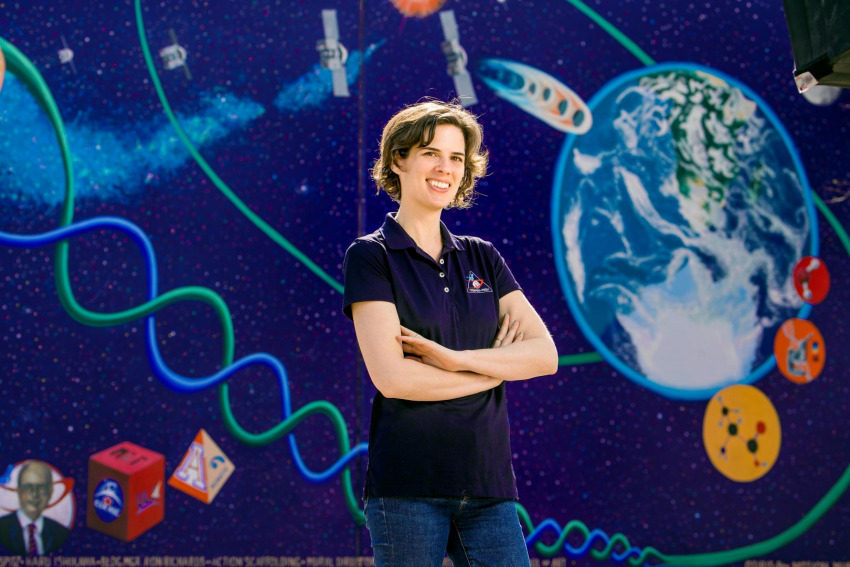
By Carina Bennett, Alumni Association - Spring 2021
I get a lot of fulfillment from my education. I love learning about new things. Chasing down the truth behind the things I wonder about is a huge driving force in my life.
I went into the Wonder animation work without expectations. They listened to my story and specifically chose an artist whose style would match mine. I wasn’t expecting that amount of care and attention.
They couldn’t have picked a better artist. The final animation was so imaginative — they created a whole world for me. During the voiceover I riffed on scripts like I was describing my work to somebody at a party. I used my creative writing background to contribute to the vision of the piece and tell stories. It was so cool.

Beyond Ordinary
Mapping Bennu: UArizona alumna’s wonder moment begins with the OSIRIS-REx mission and a pinpoint of light.
Beyond Ordinary
×
By Sarah Beaudry, Alumni Association - Spring 2021
Carina Bennett remembers her first day working on the OSIRIS-REx mission: She found herself among space scientists with years of experience. It was rocket science, but she was a filmmaker.
“There was a ton of vocabulary people threw around,” Bennett says. “I kept a list and would Google words I didn’t know.”
That determination to figure it out started early on in her University of Arizona experience. After earning bachelor’s degrees in creative writing and media arts, she earned a master’s in film production at the University of Iowa before returning to Tucson to begin her career. She started in video communications at UArizona, then joined the OSIRIS-REx imaging team.
Bennett describes herself as an “asteroid cartographer.” As she explains, all the images used for OSIRIS-REx science came through the imaging team, which removed dead or hot pixels, corrected any geometry information and ensured that pixels denoted, as accurately as possible, the latitude and longitude of points on the asteroid.
Bennett developed the main global map of Bennu, a mosaic composed of thousands of images taken from around the asteroid which were map projected into 2D space, carefully corrected, and layered together to make the map as seamless as possible.
Now that OSIRIS-REx is scheduled to leave Bennu in May with the sample it collected from the surface, the mission team will prepare for sample analysis. Bennett, too, has transitioned: to project manager and software engineer. She will be part of the team that builds a software system to pass data among scientists around the world.
“I just love my job,” Bennett says. “There’s a lot of young women on the team and people who were students hired on afterwards. I love nurturing the future generation of scientists.”
A total of 150 UArizona undergraduate and graduate students have worked on OSIRIS-REx, and more than 30 alumni have been hired to join the mission as staff. While working on the mission, Bennett continued to build her skills with another bachelor’s degree and a master’s degree, both in computer science.
Back in the days when Bennett was Googling unfamiliar science terms, she found inspiration during a meeting with Dante Lauretta. The OSIRIS-REx principal investigator Googled his own unknown words.
“I was sitting next to Dante in a meeting when somebody said something and he Googled it. I was like, ‘Oh my God, everybody’s constantly learning.’ It was a pivotal moment,” Bennett says. “There’s an empowerment in being proud that you don’t know something and wanting to figure it out. You should embrace the fact that you are always learning, instead of trying to hide it.”
Lauretta has also encouraged Bennett in her new role. “It’s intimidating to manage people who have so many years of experience,” Bennett says. “But Dante was immediately supportive. He said, ‘Well, if I thought that way when I was 35, or when I became PI of the OSIRIS-REx mission, I wouldn’t be in this position.’ “He was basically like, No, you can do this.”
Bennett is still discovering what else she can do.
“One of the things that I have learned to love about my life is that I can pivot. I don’t want to start thinking that I do space science now, and that’s all I’m going to do,” she says. “I don’t want to limit myself. I hope I don’t know where I’m going next or what the next opportunity is going to be.”
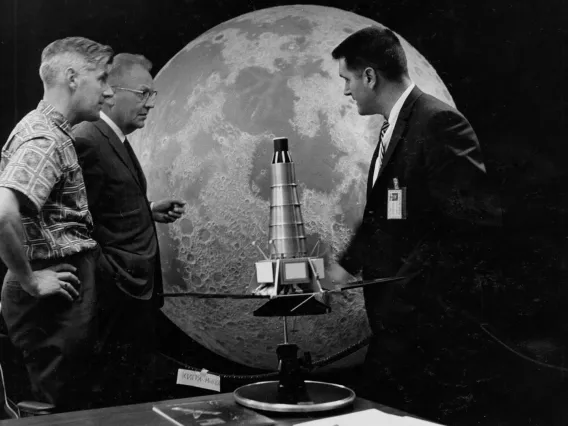
Masters of Space
Research from UArizona scientists has shaped our understanding of our solar system and universe - beginning with the Apollo 11 mission more than 50 years ago.Masters of Space
×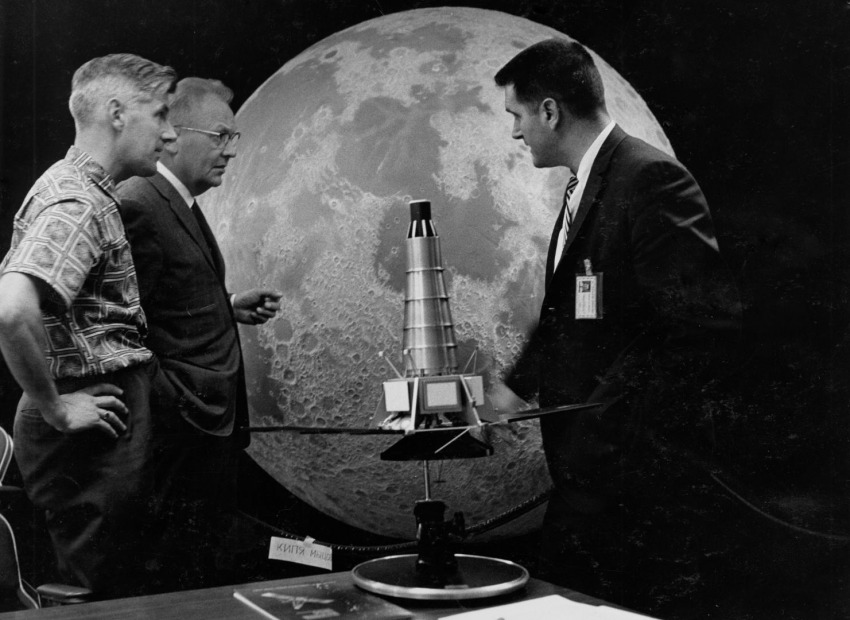
By University Communications - Spring 2021
When the first humans stepped onto the moon just over a half-century ago, on July 20, 1969, they knew they were venturing into the unknown. Some had feared the lander would be swallowed up by bottomless layers of dust, as almost nothing was known about the moon’s surface at the time. But they had the courage to trust the Apollo 11 mission team and the groundbreaking research being performed at the University of Arizona’s then-fledgling Lunar and Planetary Laboratory, or LPL.
When Gerard P. Kuiper founded the laboratory nine years earlier, in 1960, there was skepticism and a lack of interest in humans visiting the moon. But reaching the moon soon became a priority as the space race ramped up in the early ’60s. Kuiper and his UArizona laboratory were suddenly in demand.
“The UA has been a part of nearly every NASA planetary exploration mission — and with leadership roles on many of them,” says Tim Swindle, director of the UArizona Department of Planetary Sciences and LPL. “Our graduates and alumni have also been involved in many missions. That is our goal.”
William K. Hartmann, an Arizona alumnus who studied with Kuiper, was instrumental in creating some of the first maps of the moon.
“We projected photos of the moon onto a white globe, then photographed the globe from different angles to make an atlas of lunar features from overhead, as they would be seen by astronauts orbiting the moon,” Hartmann says.
Over the course of his scientific career, Hartmann discovered several impact basins on the moon. During the 1960s, he correctly predicted the age of the lunar lava plains, confirmed through samples returned by the Apollo missions.
UArizona’s LPL legacy continues today with a journey to asteroid Bennu, through the OSIRIS-REx mission and, more recently, with testing Mars exploration drones in Iceland and a mission to build a space telescope that will map vast regions of star-forming gas.

A Celestial Detective Makes Her Way From the UK to Investigate Space Rocks at Arizona
Jessica Barnes calls herself a cosmic detective. Her career path began to take shape when she discovered geosciences as an undergraduate at the University of St. Andrews in Scotland.
A Celestial Detective Makes Her Way From the UK to Investigate Space Rocks at Arizona
×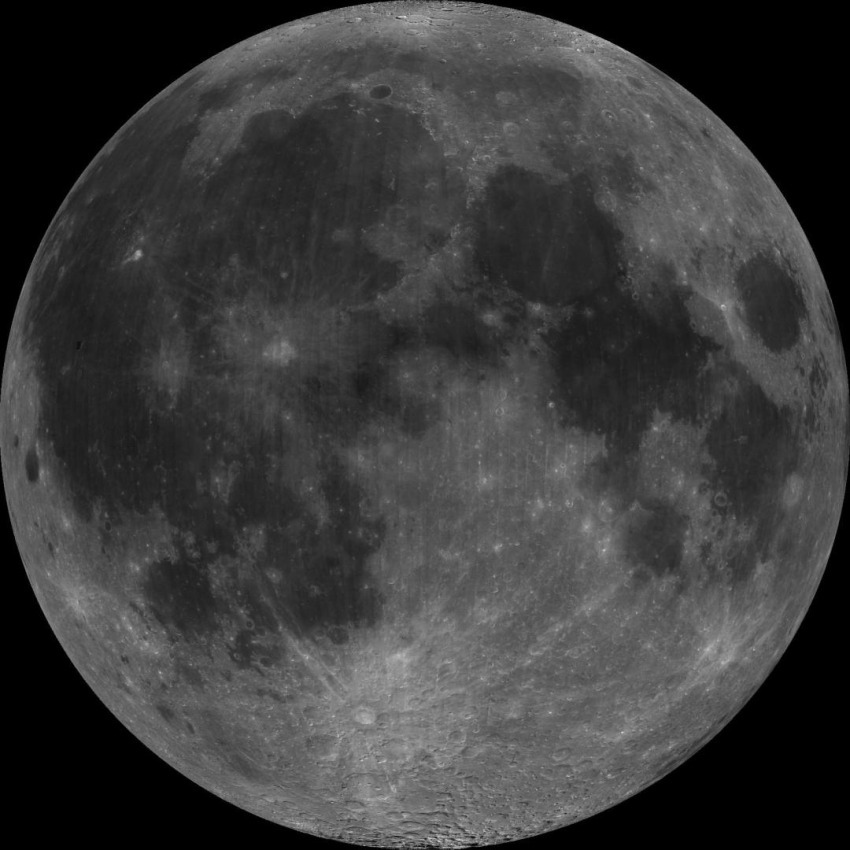
By Katy Smith, Alumni Association - Spring 2021
Jessica Barnes calls herself a cosmic detective. Her career path began to take shape when she discovered geosciences as an undergraduate at the University of St. Andrews in Scotland.
“I decided I love rocks and knowing the rocks around me tell a story of how we got here and millions of years of history,” says Barnes, an assistant professor at the University of Arizona’s Lunar and Planetary Laboratory.
As Barnes developed a concurrent interest in the planetary sciences, she chose to focus on space rocks. Their stories go even further back, as far as the origination of the solar system billions of years ago. Now, as a cosmochemist, she looks for answers to questions like: How did Earth become habitable? On what other planets might life be sustainable?
What’s Now, What’s Next
Barnes joined the LPL in 2019 following a postdoctoral fellowship at NASA’s Johnson Space Center in Houston.
“I was really excited when we were able to hire Dr. Jessica Barnes. We had identified her as somebody we wanted to recruit. I’m trying to assemble the cosmochemistry supergroup, and I knew Dr. Barnes was going to be a central member of that team,” says LPL professor Dante Lauretta.
Barnes began her work at Arizona with her current project: leading a team of researchers in examining lunar samples as part of NASA’s Apollo Next Generation Sample Analysis, or ANGSA, Program. She’s excited to work with rocks from the moon because it’s her favorite planetary body.
“It’s always there; we’re naturally curious about it. The moon is steeped in our culture and history. It’s in references in music and literature,” she says.
From a more clinical standpoint, the moon’s rocks are full of information that can be interpreted to reach a better understanding of Earth’s history. Cosmochemists believe other planetary bodies crashed into our planet, delivering water and carbon. Records of these impacts can be read in minerals, but the rocks on Earth aren’t as old as those from the moon, which was hit with the same materials.
This project will lead to another that Barnes and Lauretta both anticipate eagerly. Starting in 2023, they’ll analyze the sample returned by the OSIRIS-REx mission. NASA invested more than $1 billion on the mission, which is bringing a sample of Bennu, a hydrated carbonaceous asteroid, to Earth for analysis. Asteroids like Bennu likely played a major role in giving Earth its water.
“We’re going to bring these samples back to Earth, we’re going to bring them to our laboratories, and we’re going to unravel the early history of our solar system,” says Lauretta, the mission’s principal investigator.
The chance to be part of the OSIRIS-REx mission was one of the factors that drew Barnes to Arizona, as was the university’s history of working with NASA.
“LPL was built 50 years ago using NASA funds, and its history goes all the way back to Gerard Kuiper. It’s one of the most well-renowned planetary sciences departments in the world,” Barnes says. “And the mission is a big draw. Who gets to orbit an asteroid, essentially pogo sticking off the surface, collecting samples, bringing them back?
It’s just awesome.”
Barnes has found a supportive network of mentors and peers at Arizona and throughout her career journey as she completed her doctoral degree and made a permanent move from England. Now, she’s become a role model to others.
“I’ve been given lots of opportunities and support, and that’s what I what I hope to do for my students. I want to pay that experience forward. We’re trying to bring forward more female voices and more diversity in other ways.”
